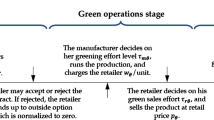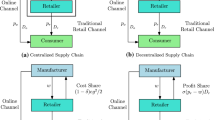Abstract
Environmental consciousness has become increasingly important in everyday life and business practice. The effort to reduce the impact of business activities on the environment has been labelled as green supply chain management. Any major greening project would require efforts on the part of the entire supply chain. However, very few studies have addressed the issue of coordinating the green supply chain. We consider the problem of coordination of a manufacturer and a retailer in a vertical supply chain, who put in efforts for ‘greening’ their operations. We address some pertinent questions in this regard such as extent of effort in greening of operations by manufacturer or retailer, level of cooperation between the two parties, and how to coordinate their operations in a supply chain. The greening efforts by the manufacturer and retailer result in demand expansion at the retail end. The decision variables of the manufacturer are wholesale price and greening effort, while those of the retailer are retail price and its greening effort. We find that the ratio of the optimal greening efforts put in by the manufacturer and retailer is equal to the ratio of their green sensitivity ratios and greening cost ratios. Further, profits and efforts are higher in the integrated channel as compared to the case of the decentralized channel. Finally, a two-part tariff contract is found to produce channel coordination in this problem. A numerical example illustrates the results.




Similar content being viewed by others
Notes
Another effect, the price premium effect, is representative of the behaviour of a consumer who is willing to pay extra for a green product. However, we do not include this aspect in the current paper.
Notice that the greening efforts can expand the demand beyond the market potential θ. This is the reason why θ is referred to as ‘base’ market potential here.
The parameter assessment of αs can be done through an empirical analysis by collecting data that relate greening costs with demand for the product. A regression analysis with demand as the dependent variable and greening investments as the independent variable could be carried out. Data for this purpose may be obtained from the similar projects handled by the organization (manufacturer or retailer) in the past.
The modelling structures similar to the one used in this paper have been used by earlier authors like Berger et al (2006), Gurnani et al (2007), and Gurnani and Erkoc (2008).
For analytical convenience, no specific parameter has been chosen for price sensitivity factor in the demand function. It may be considered as 1 throughout the paper.
As far as the performance under the integrated chain is concerned, the values of individual parameters do not matter as long as the total effectiveness parameter (manufacturer greening effectiveness coefficient+retailer greening effectiveness coefficient) is maintained at the same level. In the decentralized setup, although the results change with dissimilar values of greening effectiveness coefficients, the changes are not substantial. Therefore, we restrict ourselves to reporting results with identical values of greening effectiveness coefficients across the players in the supply chain.
References
Adamides ED, Mitropoulos P, Giannikos I and Mitropoulos I (2009). A multi-methodological approach to the development of a regional solid waste management system. Journal of the Operational Research Society 60 (6): 758–770.
Arya A and Mittendorf B (2006). Benefits of channel discord in the sale of durable goods. Marketing Science 25 (1): 91–96.
Beamon BM (1999). Designing the green supply chain. Logistics Information Management 12 (4): 332–342.
Berger PD, Lee J and Weinberg BD (2006). Optimal cooperative advertising integration strategy for organizations adding a direct online channel. Journal of the Operational Research Society 57 (8): 920–927.
Bonini SMJ and Oppenheim JM (2008). Helping ‘green’ products grow. The McKinsey Quarterly October: 1–8.
Choi SC (1991). Price competition in a channel structure with a common retailer. Marketing Science 10 (4): 271–279.
Dant RP and Berger PD (1996). Modeling cooperative advertising decisions in franchising. Journal of the Operational Research Society 47 (9): 1120–1136.
Fleischmann M, van Wassenhove LN, van Nunen JAEE, van der Laan EA, Dekker R and Bloemhof-Ruwaard JM (1997). Quantitative models for reverse logistics: A review. European Journal of Operational Research 103 (1): 1–17.
Goldbach M, Seuring S and Back S (2004). Co-ordinating sustainable cotton chains for the mass market: The case of the German mail-order business OTTO. Greener Management International 43 (Autumn): 65–78.
Gungor A and Gupta SM (1999). Issues in environmentally conscious manufacturing and product recovery: A survey. Computers & Industrial Engineering 36 (4): 811–853.
Gurnani H and Erkoc M (2008). Supply contracts in manufacturer-retailer interactions with manufacturer-quality and retailer effort-induced demand. Naval Research Logistics 55 (3): 200–217.
Gurnani H, Erkoc M and Luo Y (2007). Impact of product pricing and timing of investment decisions on supply chain co-opetition. European Journal of Operational Research 180 (1): 228–248.
Ingene C and Parry M (1995). Channel coordination when retailers compete. Marketing Science 14 (4): 360–377.
Iyer G (1998). Coordinating channels under price and non-price competition. Marketing Science 17 (4): 338–355.
Jayaraman V, Patterson RA and Rolland E (2003). The design of reverse distribution networks: Models and solution procedures. European Journal of Operational Research 150 (1): 128–149.
Jeuland AP and Shugan SM (1983). Managing channel profits. Marketing Science 2 (3): 239–272.
Jorgensen S, Taboubi S and Zaccour G (2001). Cooperative advertising in a marketing channel. Journal of Optimization Theory and Applications 110 (1): 145–158.
Kogg B (2004). Greening a cotton-textile supply chain: A case study of the transition towards organic production. Greener Management International 43 (September): 53–64.
Lee E and Staelin R (1997). Vertical strategic interaction: Implications for channel pricing strategy. Marketing Science 16 (3): 185–207.
Lee HL (2004). The triple-A supply chain. Harvard Business Review 82 (10): 102–112.
Linton JD, Klassen R and Jayaraman V (2007). Sustainable supply chains: An introduction. Journal of Operations Management 25 (6): 1075–1082.
LMI Report (2003). GREENSCOR: Developing a green supply chain analytical tool. Report LG101T4, http://postconflict.unep.ch/humanitarianaction/documents/02_08-04_05-11.pdf, accessed 28 May 2011.
Manget J, Roche C and Münnich F (2009). Capturing the green advantage for consumer companies. January, The BCG Inc. Report, http://www.bcg.com/expertise_impact/publications/PublicationDetails.aspx?id=tcm:12-15409, accessed 28 May 2011.
McGuire T and Staelin R (1983). An industry equilibrium analysis of downstream vertical integration. Marketing Science 2 (2): 161–192.
Mitra S and Webster S (2008). Competition in remanufacturing and effects of government subsidies. International Journal of Production Economics 111 (2): 287–298.
Moorthy K (1987). Managing channel profits: Comment. Marketing Science 6 (4): 375–379.
Moorthy K (1988). Strategic decentralization in channels. Marketing Science 7 (4): 335–355.
Pachauri RK and Reisinger A (eds.) (2007). Intergovernmental Panel on Climate Change. Climate Change 2007: Synthesis report. Summary for Policy Makers, IPCC, Geneva.
Plambeck E (2007). The greening of Wal-Mart’s supply chain. Supply Chain Management Review 11 (5): 18–25.
Rao P (2002). Greening the supply chain: A new initiative in south East Asia. International Journal of Operations and Production Management 22 (6): 632–655.
Rao P and Holt D (2005). Do green supply chains lead to competitiveness and economic performance? International Journal of Operations & Production Management 25 (9): 898–912.
Raut S, Swami S, Lee E and Weinberg CB (2008). How complex do movie channel contracts need to be? Marketing Science 27 (4): 627–641.
Sarkis J (2003). A strategic decision framework for green supply chain management. Journal of Cleaner Production 11 (4): 397–409.
Savaskan RC and van Wassenhove LN (2006). Reverse channel design: The case of competing retailers. Management Science 52 (1): 1–14.
Simpson DF and Power DJ (2005). Use the supply relationship to develop lean and green suppliers. Supply Chain Management 10 (1): 60–68.
Simpson DF, Power DJ and Samson D (2007). Greening the automotive supply chain: A relationship perspective. International Journal of Operations & Production Management 27 (1): 28–48.
Srivastava SK (2007). Green supply chain management: A state-of-the-art literature review. International Journal of Management Reviews 9 (1): 53–80.
Srivastava SK (2008). Network design for reverse logistics. Omega 36 (4): 535–548.
Vachon S and Klassen RD (2006). Extending green practices across the supply chain: The impact of upstream and downstream integration. International Journal of Operations and Production Management 26 (7): 795–821.
Vachon S and Klassen RD (2008). Environmental management and manufacturing performance: The role of collaboration in the supply chain. International Journal of Production Economics 111 (2): 299–315.
Walton SV, Handfield RB and Melnyk SA (1998). The green supply chain: Integrating suppliers into environmental management processes. Journal of Supply Chain Management 34 (2): 2–11.
White L and Lee GJ (2009). Operational research and sustainable development: Tackling the social dimension. European Journal of Operational Research 193 (3): 683–692.
Wilkerson T (2005a). Best practices in implementing green supply chains. North America Supply Chain World Conference and Exposition, 5 April, http://postconflict.unep.ch/humanitarianaction/documents/02_08-04_05-25.pdf, accessed 28 May 2011.
Wilkerson T (2005b). Can one green deliver another? Harvard Business School Publishing Corporation, http://www.supplychainstrategy.org, accessed 28 May 2011.
World Summit on Sustainable Development (WSSD) (2002). Johannesburg, 26 August – 4 September, http://www.iisd.ca/2002/wssd/, accessed 28 May 2011.
Zhang HC, Kuo TC, Lu H and Huang SH (1997). Environmentally conscious design and manufacturing: A state-of-the-art survey. Journal of Manufacturing Systems 16 (5): 352–371.
Acknowledgements
The authors are grateful to P.D. Jose, IIM Bangalore, India, Eunkyu Lee, Syracuse University, USA, and Charles Weinberg, UBC, Canada, for useful comments and discussion. The first author acknowledges the support provided by Supply Chain Management Center (SCMC), IIM Bangalore during his stays as visiting faculty in 2009–2011.
Author information
Authors and Affiliations
Corresponding author
Rights and permissions
About this article
Cite this article
Swami, S., Shah, J. Channel coordination in green supply chain management. J Oper Res Soc 64, 336–351 (2013). https://doi.org/10.1057/jors.2012.44
Received:
Accepted:
Published:
Issue Date:
DOI: https://doi.org/10.1057/jors.2012.44




